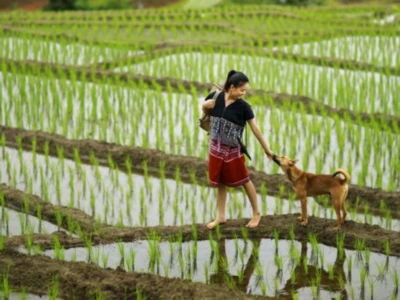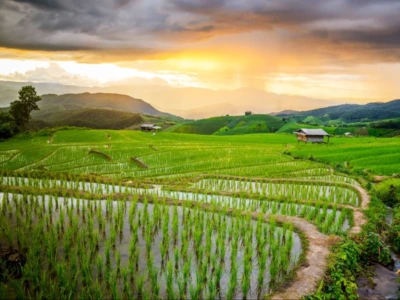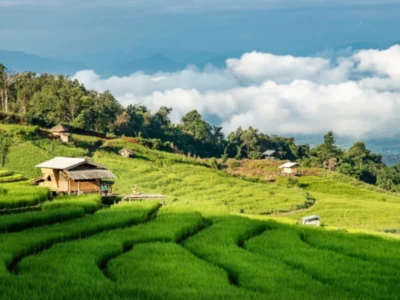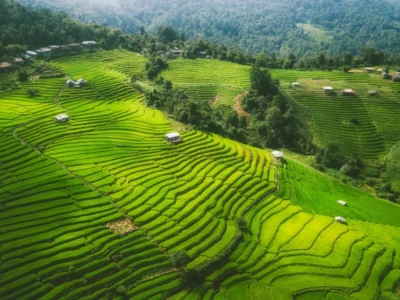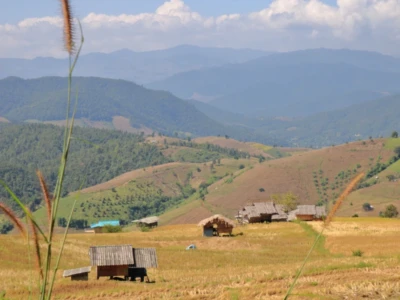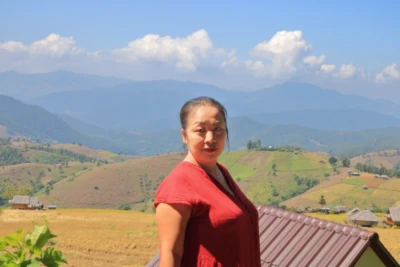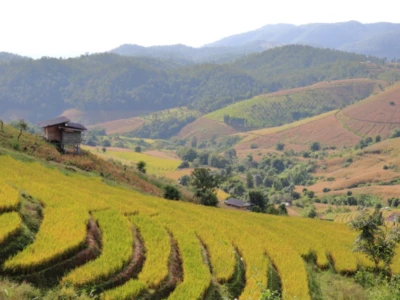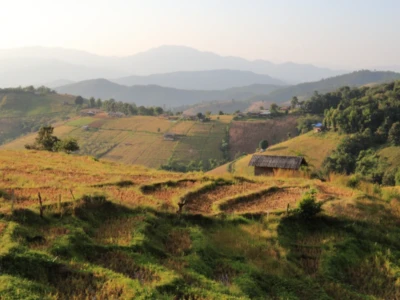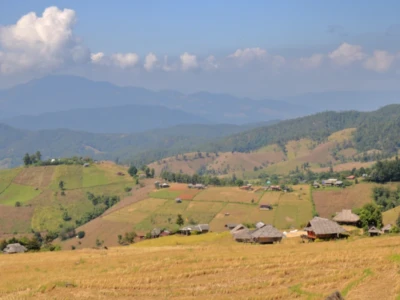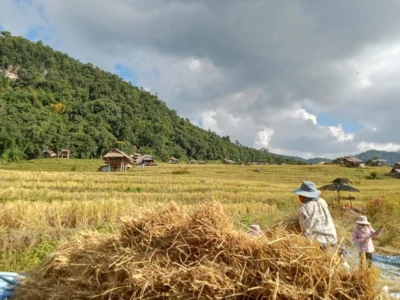Lanna Atlas / Natural Sights / Ban Pa Pong Piang
Ban Pa Pong Piang, the most beautiful terraced rice fields in Thailand
Ban Pa Pong Piang, a village of rice terraces in Doi Inthanon National Park, is a hidden gem near Chiang Mai and one of the most photogenic spots in Thailand. Staying overnight is recommended to fully experience tranquility away from tourist crowds and capture sunrise and sunset over the terraces.
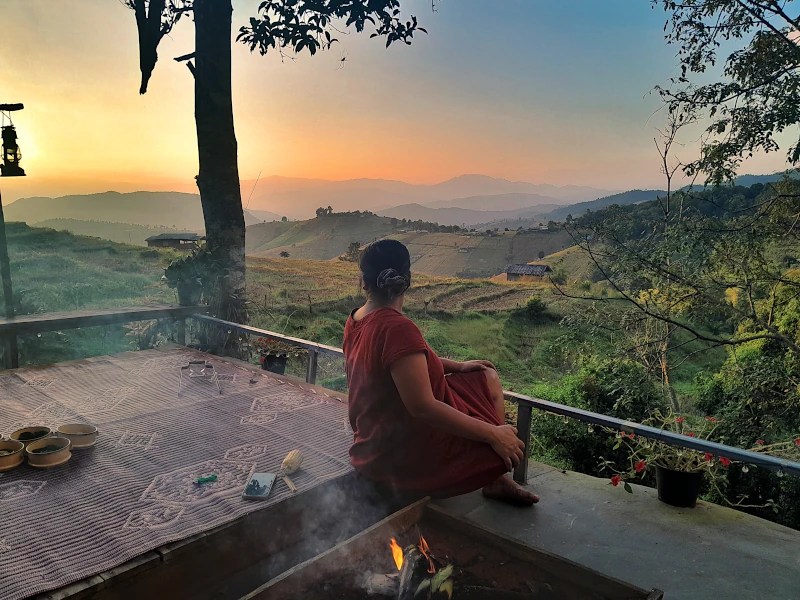
About Ban Pa Bong Piang
Ban Pa Bong Piang’s rice terraces are located on the western, “remote” slope of Doi Inthanon Mountain, in the mountainous Mae Chaem district of Chiang Mai province. The name translates from the northern Thai dialect as “village (Ban) of bamboo forest (Pa Bong) on the flat mountain ridge (Piang).” These hills were once covered with bamboo groves, which the Karen villagers gradually cleared to create rice fields.
The Karen-Po hill tribe people (not to be confused with the “long-neck Karen”, or Padaung!) are the largest ethnic minority in the Mae Chaem district. Living in villages situated at higher elevations than those of ethnic Thais, they have developed deep spiritual connections to the natural world and possess intricate knowledge of local ecosystems. Their terraced rice fields are ingeniously designed to create flat areas on steep slopes, ensuring the paddies remain flooded—an essential condition for successful rice cultivation.
Since Ban Pa Bong Piang gained popularity among Thai social media influencers and became recognized as one of Thailand’s must-see rice terraces, the local Karen community has begun converting some traditional houses into homestays, offering visitors an authentic experience of local life.
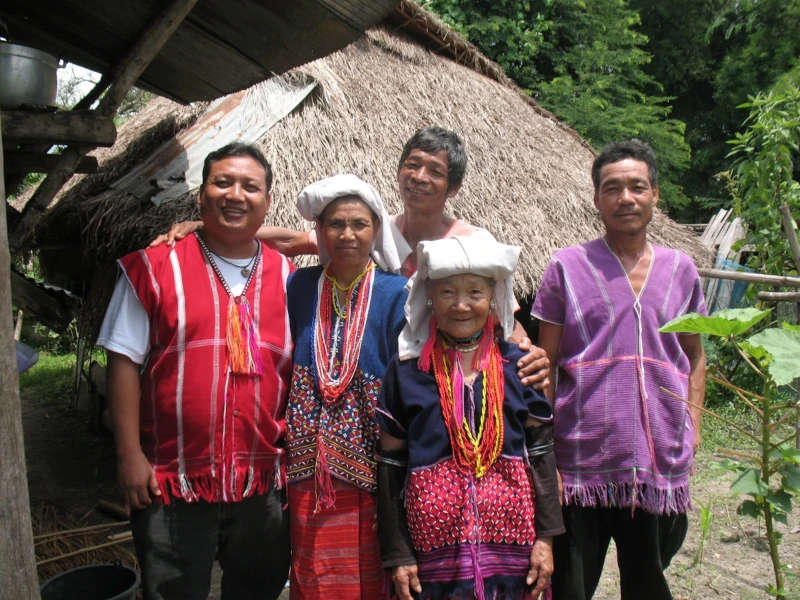
When to visit
Don’t go to Pa Pong Piang during the Burning Season, also known locally as “haze season,” which typically occurs between February and May, with peak intensity in March and April. During this time, the air quality is poor, visibility is severely limited, and all surrounding homestays, cafes, shops, and restaurants are closed.
The best time to visit is between July and November, during the rice-growing and harvest seasons. This period can be divided into three main phases:
- Rice Planting (July – August)
The rice planting season is the ideal time to capture classic photos of the terraced fields, with young rice stalks and the water reflecting the sky and the clouds, as shown in these photos sourced from the internet.
- Lush Green Rice Terraces (August – September)
By August and September, the rice fields transform into a vibrant sea of green as the plants grow densely:
- Rice Harvest (October – November)
In October, the fields turn yellow as the rice ripens and nears harvest time. November gives a perfect opportunity to witness the traditional rice harvesting process and capture stunning golden hues. We took these photos in November 2024:
Local accommodations
While it’s possible to visit Ban Pa Bong Piang on a day trip from Chiang Mai, staying overnight lets you experience the serene beauty of the rice terraces during sunrise and sunset, fully immersing yourself in nature.
The area features eight homestays with several dozen cottages nestled among the rice fields. While all cottages provide picturesque views, their perspectives vary depending on location. For the most sweeping views of the terraces, consider staying in a cottage closer to the top near the road. Lower-lying cottages might offer fewer panoramic views but allow you to wake up amidst enchanting morning fog.
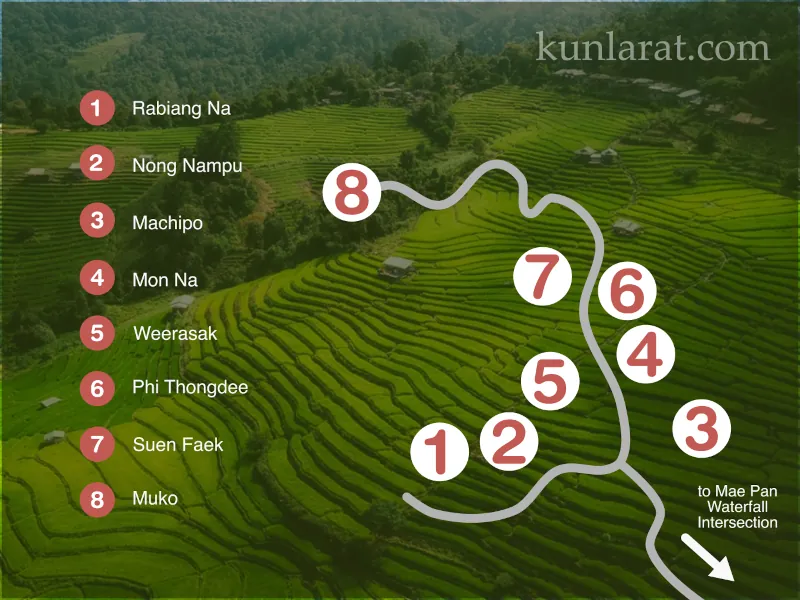
Accommodations are simple bamboo huts built in the traditional Karen style, perched on the mountainside with terraces overlooking the rice fields. Each hut typically includes two small rooms with floor mattresses, pillows, mosquito nets, and blankets, offering an authentic glimpse into village life. Bathrooms are shared and located in small outdoor sheds, featuring cold-water showers due to the lack of electricity and water heaters.
All homestays charge the same rate of 500 THB per person per night, including dinner and breakfast. It’s advisable to call ahead to book, especially during the peak season (July–October) and weekends, as accommodations can fill up weeks or even months in advance.
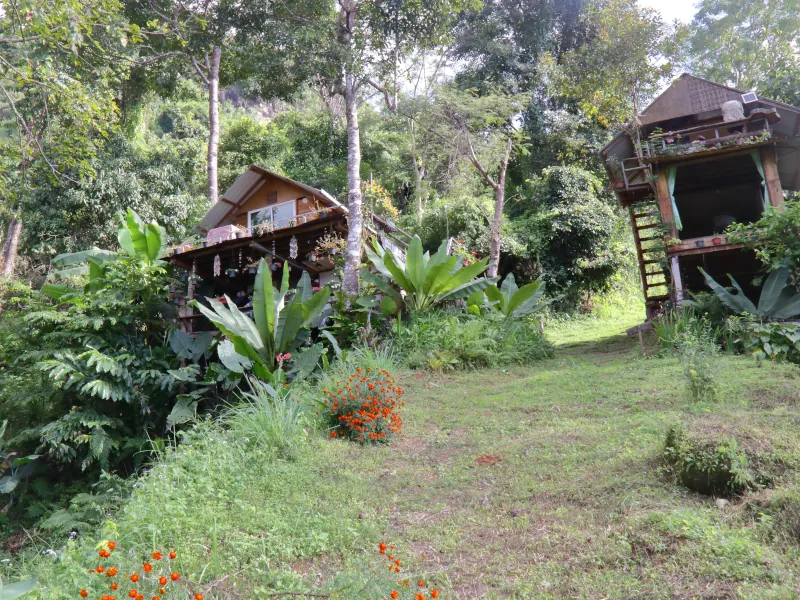
By contrast, November is quieter, with many cottages unoccupied. During our November visit, we met a local in the parking area who guided us to view available cottages. After choosing one near a soothing mountain stream, we paid 1,000 THB and settled in. Before sunset, another local arrived with our dinner, providing a charmingly informal but warm hospitality experience.
Food
Accommodation includes dinner and breakfast, as there are no restaurants or traditional Thai street food stalls within tens of kilometers. The only store we found in the village offered basic supplies like rice, eggs, vegetable oil, and instant noodles. Homestay owners prepare meals at home and deliver them to guests in tiffin carriers.
Our dinner consisted of a generous portion of steamed rice, an omelet, and Karen-style warm vegetable salads.
Getting there
By your car or bike
To get from Chiang Mai to Ban Pa Bong Piang, head south on Route 108 toward Chom Thong (about 60 km). In Chom Thong, turn right onto Route 1009 toward Doi Inthanon National Park.
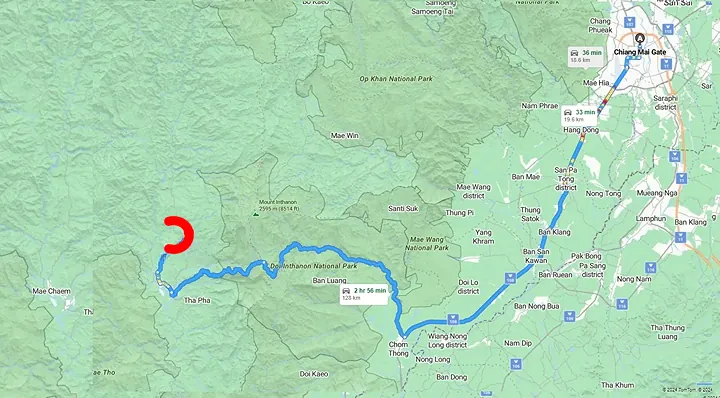
The road to Baan Pa Bong Piang village, like the entire remote amphoe (district) of Mae Chaem to which it belongs, passes through Doi Inthanon National Park. However, this amphoe is located OUTSIDE the national park, on its “opposite” side. A significant portion of traffic passing through the park checkpoint is heading there, and their drivers and passengers do not pay an entrance fee – they simply say they are going to Mae Chaem.
Accordingly, YOU DO NOT HAVE TO PAY Doi Inthanon’s park entrance fee (300 THB for foreign adults and 150 THB for children, and 30/20 THB car/motorbike fee).
Don’t buy tickets at the 1st checkpoint. When stopped at the 2nd checkpoint (37 km from Chom Thong) by the ticket checker, simply tell him “mâe-jàem” or “bpai mâe-jàem” (going to Mae Chaem), and point with your hand to the left turn for certainty. The road immediately splits after the checkpoint, with the left branch leading to Amphoe Mae Chaem, and the right branch going to Inthanon mountain peak.
The Park Entry Staff will undoubtedly ensure you turn left. They will radio your details if you go right, and other park staff will meet you at the summit. On the return trip, though, some cunning travelers save on entrance fees by exiting the road from Mae Chaem and suddenly turning towards Doi Inthanon, instead of going to the checkpoint. But we won’t do that, right?
2nd Checkpoint on Google Maps: https://maps.app.goo.gl/r7wK12EmQvHHXFmc6
After turning left to the local road to Mae Chaem, follow this road for 6.5 km until you reach the sign for “Mae Pan Waterfall”. Then turn right and continue the final 4 km to Ban Pa Bong Piang.
Mae Pan Waterfall Intersection on Google Maps: https://maps.app.goo.gl/eLC45tuHTUhsmLZc8
By local transport
Traveling by local transport is the most affordable option but also the slowest, least comfortable, and somewhat complex. The journey involves three stages:
1. Chiang Mai to Chom Thong
Begin at Chiang Mai Gate (Pratu Chiang Mai), the southern gate of the Old City near the Saturday Walking Street. From here, you can take either a yellow songthaew (departing outside the city wall) or a blue bus (departing inside the wall). The blue bus offers a more comfortable ride, with proper forward-facing seats, while the yellow songthaews leave more frequently, about every 20 minutes. Confirm with the driver that the vehicle is headed to Chom Thong before boarding. The trip takes approximately 1.5 hours and costs 35 THB per person. You’ll arrive at a small bus station near Wat Phra That Si Chom Thong Worawihan, directly opposite the market.
2. Chom Thong to Mae Chaem
From the Chom Thong bus station, yellow songthaews to Mae Chaem depart every two hours, starting at 9:30 a.m. and ending at 3:30 p.m. The fare is 70 THB per person. Before boarding, confirm with the driver that the songthaew goes to Mae Chaem and mention that you’re headed to Ban Pa Pong Piang (or “Mae Pan Waterfall”). The journey takes about 1.5 hours along winding mountain roads. You’ll be dropped off at the intersection near the “Mae Pan Waterfall” road sign.
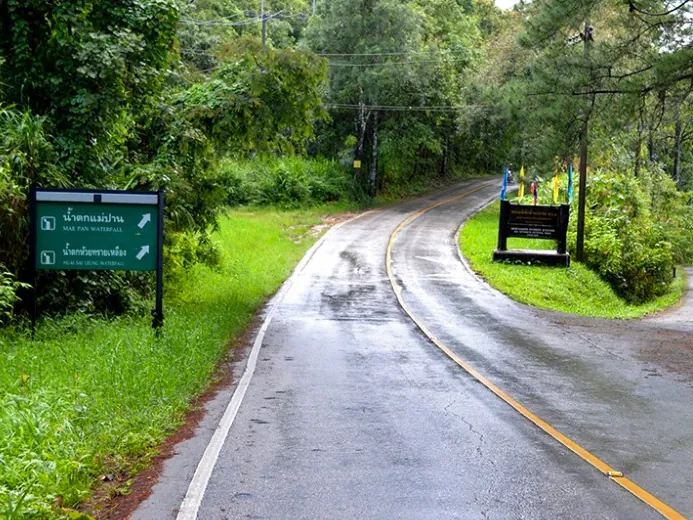
3. From Mae Pan Waterfall Intersection to Ban Pa Pong Piang
From the drop-off point, you’ll need to walk 4–6 kilometers along the local road to reach your homestay, depending on its location. Alternatively, you can arrange for your homestay to pick you up from the intersection. The cost for a roundtrip ride typically ranges between 500 and 1,000 THB for the entire group, not per person.
This route offers a true local experience, but it’s best suited for travelers with flexible schedules and a sense of adventure.
By car with a driver
Hiring a private car or van with a driver is the easiest whough not the cheapest way to reach Ban Pa Bong Piang. During the low tourist season (May to November) in Chiang Mai, the cost for a car with a driver-guide typically ranges from 2,500 THB per day to 5,000 THB if you plan to stay overnight.
At least, you can book a one-day group tour by minivan to Doi Inthanon through a travel agency. Some tours might include visiting Ban Pa Bong Piang—confirm this with the agency in advance! Prices usually range from 1,200 to 1,500 THB per person and generally include transportation, an English-speaking guide, entry fees, lunch, and visits to popular attractions like the Twin Pagodas, Wachirathan Waterfall, and occasionally the Angka Nature Trail.

